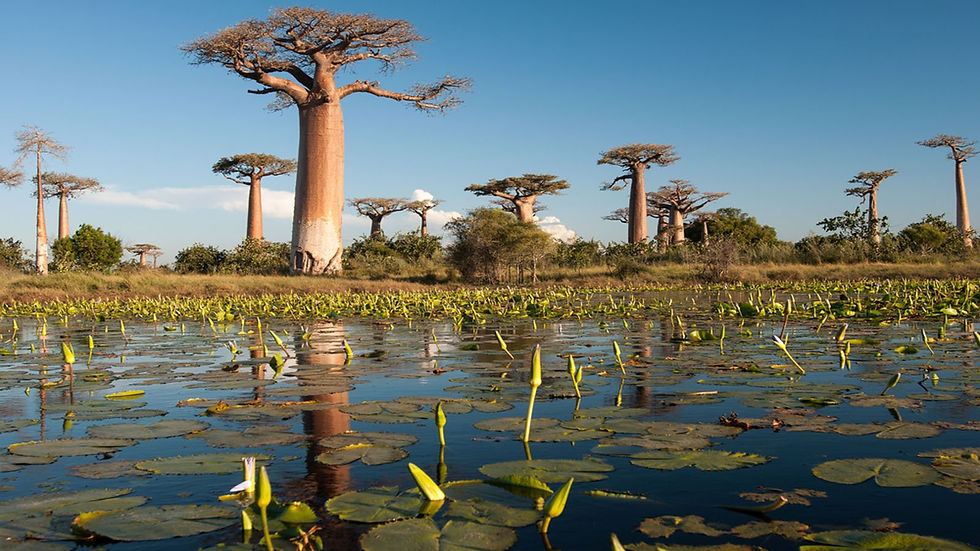Madagascar, A Unique Island Nation
- Iruni Kalupahana

- Oct 27, 2024
- 3 min read
Iruni Kalupahana JadeTimes Staff
I. Kalupahana is a Jadetimes news reporter covering Africa

Geography and Location
Madagascar is the fourth largest island globally, covering around 226,658 square miles. Located approximately 250 miles from the African coast, Madagascar sits between Africa and the Indian Ocean. The Malagasy people, despite Madagascar's proximity to Africa, share cultural and linguistic ties with Indonesians. This unique blend of influences has made Madagascar culturally distinct from both Africa and Asia. Formerly a French colony, Madagascar gained independence in 1960, yet the French language remains prevalent, fostering political, economic, and cultural links with other French speaking countries in western Africa. This island nation has since developed a diverse cultural identity, influenced by various migration patterns, colonial history, and trade routes.
Topography and Landforms
Madagascar’s landscape is divided into three main geographic zones, the central plateau, the eastern coastal strip, and the low plateaus in the west. The central plateau, rising between 2,500 and 4,500 feet above sea level, has been shaped by volcanic and tectonic activity, resulting in rugged terrains and sharp cliffs, such as the prominent Angavo Cliff. Its highest point, Maromokotro in the Tsaratanana Massif, reaches 9,436 feet and is a key landmark. The island is dotted with volcanic features, such as Tsiafajavona, an ancient volcanic peak in the Ankaratra Massif. Madagascar’s westward rivers like the Mangoky and Betsiboka create fertile estuaries and plains, while the eastern coast is characterized by short, fast moving rivers flowing down steep cliffs and forming scenic waterfalls. Sedimentary rock in the west and fertile volcanic soils on the plateau support varied agriculture, with fertile valleys particularly abundant around Lake Alaotra, the island’s largest lake and a critical farming area.

Climate and Vegetation
Madagascar has a tropical climate influenced by the southeast trade winds and the northwest monsoon. The east coast receives significant rainfall, up to 150 inches annually in areas like Maroantsetra, while the western side falls in a rain shadow and is significantly drier. The island’s two seasons the wet season from November to April and the cooler dry season from May to October create diverse habitats. Historically, Madagascar was covered by lush evergreen and deciduous forests, now mostly replaced by grasslands and shrublands due to extensive deforestation. However, unique vegetation persists, particularly in the east, with dense forests, palms, and screw pines. The arid southern region hosts a variety of drought resistant plants, such as baobabs, giant cacti, and succulents like pachypodiums, which are exclusive to Madagascar’s ecosystem.
Wildlife and Culture
Madagascar’s isolation has fostered an extraordinary range of endemic species, with about 90% of its wildlife found nowhere else on Earth. This includes around 40 species of lemurs, such as the ring tailed lemur and the tiny mouse lemur, the smallest primate in the world. Other native creatures include the tenrec, a hedgehog like insectivore, and numerous chameleons, reptiles, and amphibians. The island has a rich bird population, from vibrant ibis and flamingos to endemic cuckoo and raptor species. The Malagasy people maintain ancestral worship traditions, with about two fifths practicing a religion focused on Zanahary (the Creator) or Andriamanitra (the Fragrant One). Malagasy culture emphasizes respect for ancestors and taboos, known as "fady," which vary by region and often dictate daily life. This vibrant culture, combined with a commitment to environmental conservation, reflects a complex and resilient society shaped by its unique natural surroundings and deep rooted traditions.










































Comments